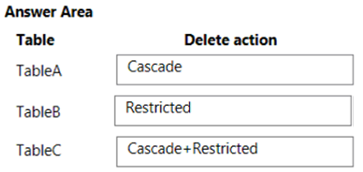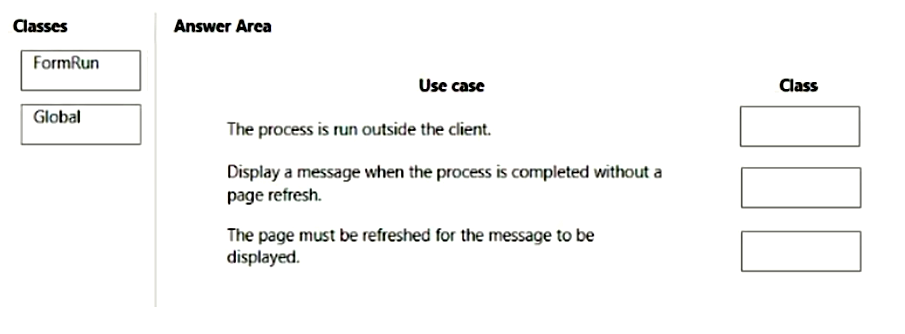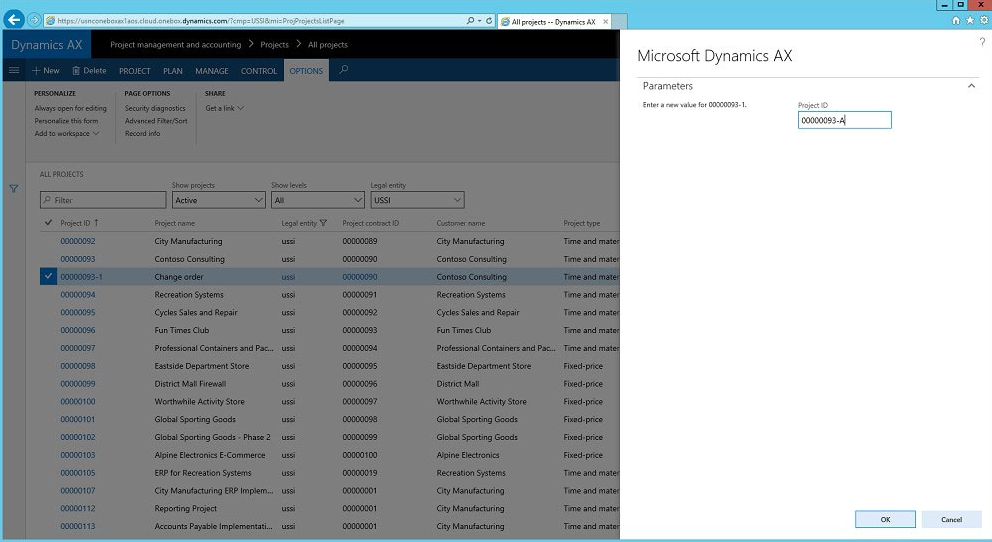Question 1
You are a Dynamics 365 Finance developer.
You have a table named FMVehicle that contains a field named VehicleId. The table has an index named VehicleIdIdx on the VehicleId field. You declare a table buffer named vehicle to refer to the table.
You need to select all records from the FMVehicle table in ascending order based on VehicleId field in the vehicle variable.
Which embedded-SQL statement should you use?
- A. select vehicle index VehicleId;
- B. select vehicle index VehicleIdIdx;
- C. select VehicleId from vehicle order by VehicleIdIdx asc;
- D. select vehicle order by VehicleId desc;
Answer:
b
The 'index VehicleIdIdx' statement will cause an Order By Asc of the fields contained in the index. In this case, that means an Order By Asc of the VehicleID field.
Comments
Question 2
Note: This question is part of a series of questions that present the same scenario. Each question in the series contains a unique solution that might meet the stated goals. Some question sets might have more than one correct solution, while others might not have a correct solution.
After you answer a question in this section, you will NOT be able to return to it. As a result, these questions will not appear in the review screen.
You create a new form in a project.
You need to display tabs in a vertical alignment.
Solution: Apply the Details Master pattern.
Does the solution meet the goal?
- A. Yes
- B. No
Answer:
a
Reference:
https://docs.microsoft.com/en-us/dynamics365/fin-ops-core/dev-itpro/user-interface/details-master-form-pattern
Comments
Question 3
You are a Dynamics 365 Finance developer.
You need to create an extension class.
Which action should you perform?
- A. Mark the class as final.
- B. Add the class buffer as the first parameter.
- C. Mark the class as protected.
- D. Mark the class as public.
Answer:
a
Extension classes are final classes that are adorned with the ExtensionOf attribute and that also have a name that has the _Extension suffix.
Because the classes are instantiated by the runtime system, it's not meaningful to derive from the extension class. Therefore, the extension class must be marked as final.
Reference:
https://docs.microsoft.com/en-us/dynamics365/fin-ops-core/dev-itpro/extensibility/method-wrapping-coc
Comments
Question 4
DRAG DROP
A company uses Dynamics 365 Finance.
You create the following tables:
You need to configure the system to meet the requirements.
Which delete actions should you use? To answer, drag the appropriate delete action types to the correct scenarios. Each delete action may be used once, more than once, or not at all. You may need to drag the split bar between panes or scroll to view content.
NOTE: Each correct selection is worth one point.
Answer:

Comments
Question 5
DRAG DROP
You are a Dynamics 365 Finance developer.
A long running process times out in the system.
You need to implement the asynchronous framework to resolve this issue.
Which class runAsync method should you use for each use case? To answer, drag the appropriate classes to the correct use cases. Each class may be used once. more than once, or not at content.
NOTE: Each correct selection is worth one point.
Answer:

Comments
Question 6
HOTSPOT
You are a Dynamics 365 finance developer. You check out elements from version control in order to make modifications.
You need to check in the modified elements to version control.
What should you do? To answer, select the appropriate option in the answer area.
NOTE: Each correct selection is worth one point.
Answer:

Comments
Question 7
You need to investigate the Vendor exclusion list issue.
What should you do?
- A. Navigate to the General tab and select Database log
- B. Navigate to the Page options tab, select Record Info, and then select Show all fields.
- C. Navigate to the Options tab and select Personalize this form. Add a field button and the required field.
- D. Navigate to the General tab, select Record Info, and then select Show all fields.
Answer:
b
Note: A sales manager suspects a data-related issue in the vendor exclusion list. User1 must identify the user who created the referenced exclusion records.
On each form in Microsoft Dynamics AX, there is a menu item Record info on the OPTIONS menu tab page.
Click on the Record info button to get the next dialog presented.
The dialog gives you also the option to show all fields or view database log records related to a certain record.
Reference:
https://kaya-consulting.com/en/how-to-rename-records-in-ax7/
Comments
Question 8
Note: This question is part of a series of questions that present the same scenario. Each question in the series contains a unique solution that might meet the stated goals. Some question sets might have more than one correct solution, while others might not have a correct solution.
After you answer a question in this section, you will NOT be able to return to it. As a result, these questions will not appear in the review screen.
A company is implementing Dynamics 365 finance and operations apps.
The company must test the functionality of its native Dynamics 365 finance and operations apps by using the Acceptance test library (ATL).
You need to implement ATL classes on test data within a development environment.
Solution: Create a set of navigation objects and creator classes to access entities and test data.
Does the solution meet the goal?
- A. Yes
- B. No
Answer:
b
Comments
Question 9
You are a Dynamics 365 Finance developer. You have two tables as shown in the following exhibit:
You need to configure Table1 to ensure that records cannot be deleted from Table1 if Table2 contains related records.
Which value should you use for the OnDelete property?
- A. None
- B. Cascade
- C. Cascade + Restricted
- D. Restricted
Answer:
d
Example of Restricted -
Suppose we have two tables (Customer & Order) and the relation is of One-To-Many i.e Customer can have many orders.
So on a parent table i.e.(Customer) if I set a delete action property to RESTRICTED for Order table. Then If I go and delete the record from a Customer table. It will first check the record in the child table and if exist that warning prompt saying that first we need to delete a record from child table.
Incorrect Answers:
B: Example of Cascade:
Suppose we have two tables (Customer & Order) and the relation is of One-To-Many i.e. Customer can have many orders.
So on a parent table i.e.(Customer) if I set a delete action property to CASCADE for Order table. Then If I go and delete the record from a Customer table. It will also delete all the related records in Order table automatically.
C: Example of Cascade + Restricted
Suppose we have three tables (Person ,Customer & Order) Now Person is a parent of Customer table, and Customer is a parent of Order table having (One-To-
Many) relations -
If I set a Delete action property on Person table to CASCADE for customer table and If I set a Delete Action property on a CUSTOMER table for Order table to
CASCADE +RESTRICTED.
So if I delete a record from Customer table then It will first check the record in the child table(order table) and if exist that warning prompt saying that first we need to delete a record from child table.
But if I delete a record from Person table it will automatically delete a record in Customer table and all records related to customer table in Order table would also be deleted.
Reference:
https://amazingax.wordpress.com/2013/01/13/microsoft-dynamics-ax-2012example-of-cascaderestricted-and-cascade-restricted-delete-action-property-for-a- table-relation/
Comments
Question 10
You need to configure security for the Vendor Exclusion List report.
What are two possible ways to achieve this goal? Each correct answer presents a complete solution.
NOTE: Each correct selection is worth one point.
- A. Create a new privilege, add a reference to an output menu item, and then add the new privilege to a role.
- B. Create a new security policy and add an output menu item. Add the new security policy to duty extension and then to a role extension.
- C. Create a new privilege extension and add an output menu item. Add the privilege to a duty extension and then to a role extension.
- D. Create a new privilege and assign it to an output menu item. Add the new privilege to a duty extension and then add the duty extension to a role.
Answer:
ad
Scenario: Develop necessary security permissions to view and maintain the new Vendor exclusion list functionality and reporting. Users with maintain rights will be able to create, update, and delete the exclusion list. Permissions must be assigned to security roles to match company security model.
The privileges are simply a way to grant permissions to an entry point, which can be services, to a duty, role, or even directly to a user. Typically, we only add entry points to a privilege, such as menu items.
D: You can extend a Security Role or a Security Duty to add new duties/privileges to these elements.
Incorrect Answers:
C: We can't extend security privileges, we would always create a new privilege.
Reference:
https://www.oreilly.com/library/view/extending-microsoft-dynamics/9781786467133/40a348f3-0f4c-4d47-a566-59f3a2e6afa0.xhtml https://docs.microsoft.com/en-us/dynamics365/fin-ops-core/dev-itpro/extensibility/customization-overlayering-extensions#security-role-and-duty-extensions
Comments
Page 1 out of 25
Viewing questions 1-10 out of 257
page 2